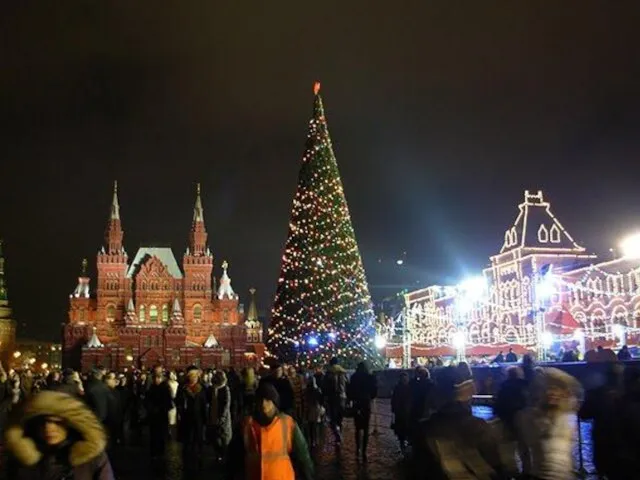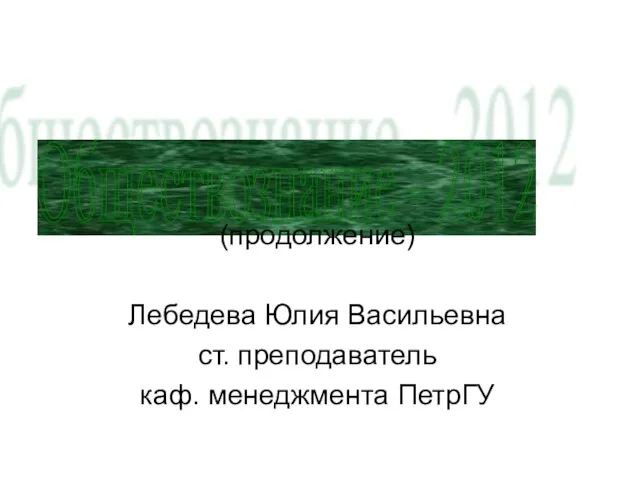Содержание
Слайд 2Russian Christmas Religious Traditions
Russian Orthodox Christmas takes place on January 7th (following
Russian Christmas Religious Traditions
Russian Orthodox Christmas takes place on January 7th (following

the Old Calendar this is the 25th of December) and the celebration lasts for six days.
In the Orthodox tradition nothing is eaten or drunk on Christmas Eve until the first star appears in the sky. The star is symbolic of the great star that led the Magi to the newly born Christ. Once the first star has appeared in the sky, the festivities begin with a Lenten meal - meaning meat or dairy products (including chocolates) are excluded. This Christmas Eve meal is "The Holy Supper" .
The family gathers around the table to honor the coming Christ Child. A white tablecloth is used to symbolize Christ's swaddling clothes and hay is displayed as a reminder of the poverty of the place where Jesus was born. A tall white candle is placed in the center of the Table, to symbolize Christ - the "Light of the World." A large round loaf of "pagach", a special Lenten bread, is placed beside the candle to symbolize Christ - the "Bread of Life".
The father begins the Christmas meal by leading the family in the Lord's Prayer, a prayer of thanksgiving for the blessings of the past year and for the good things to come in the new year. The head of the family greets those present with "Christ is Born!" - the traditional Russian Christmas greeting - and the family responds with "Glorify Him!" The Mother then draws a cross with honey on each person's forehead, saying a blessing - "In the Name of the Father and of the Son and of the Holy Spirit, may you have sweetness and many good things in life and in the new year." The Lenten bread (Pagach) is then broken and shared. The bread is dipped first in honey to symbolize the sweetness of life and then in chopped garlic to symbolize life's bitterness. The "Holy Supper" is then eaten. After dinner, no dishes are washed and the Christmas presents are opened. The family goes to church for the Christmas Mass which lasts until after midnight.
In the Orthodox tradition nothing is eaten or drunk on Christmas Eve until the first star appears in the sky. The star is symbolic of the great star that led the Magi to the newly born Christ. Once the first star has appeared in the sky, the festivities begin with a Lenten meal - meaning meat or dairy products (including chocolates) are excluded. This Christmas Eve meal is "The Holy Supper" .
The family gathers around the table to honor the coming Christ Child. A white tablecloth is used to symbolize Christ's swaddling clothes and hay is displayed as a reminder of the poverty of the place where Jesus was born. A tall white candle is placed in the center of the Table, to symbolize Christ - the "Light of the World." A large round loaf of "pagach", a special Lenten bread, is placed beside the candle to symbolize Christ - the "Bread of Life".
The father begins the Christmas meal by leading the family in the Lord's Prayer, a prayer of thanksgiving for the blessings of the past year and for the good things to come in the new year. The head of the family greets those present with "Christ is Born!" - the traditional Russian Christmas greeting - and the family responds with "Glorify Him!" The Mother then draws a cross with honey on each person's forehead, saying a blessing - "In the Name of the Father and of the Son and of the Holy Spirit, may you have sweetness and many good things in life and in the new year." The Lenten bread (Pagach) is then broken and shared. The bread is dipped first in honey to symbolize the sweetness of life and then in chopped garlic to symbolize life's bitterness. The "Holy Supper" is then eaten. After dinner, no dishes are washed and the Christmas presents are opened. The family goes to church for the Christmas Mass which lasts until after midnight.
Слайд 3Holy Supper
Traditionally, the "Holy Supper" consists of 12 different foods, symbolic of
Holy Supper
Traditionally, the "Holy Supper" consists of 12 different foods, symbolic of

the 12 Apostles. Although there was also some variation in the foods from place to place and village to village, the following is a good summary of what is typically served.
1) Mushroom soup
2) Lenten bread
3) Chopped garlic
4) Honey
5) Baked fish
6) Fresh Oranges, Figs
7) Nuts
8) Kidney beans, seasoned with shredded potatoes, lots of garlic, salt and pepper
9) Peas
10) Parsley Potatoes
11) Small biscuits combined with sauerkraut or poppy seed with honey
12) Red Wine
1) Mushroom soup
2) Lenten bread
3) Chopped garlic
4) Honey
5) Baked fish
6) Fresh Oranges, Figs
7) Nuts
8) Kidney beans, seasoned with shredded potatoes, lots of garlic, salt and pepper
9) Peas
10) Parsley Potatoes
11) Small biscuits combined with sauerkraut or poppy seed with honey
12) Red Wine
- Предыдущая
THE RUSSIAN MUSEUMСледующая -
Airport Infrastructure & Operation 

 Обществознание - 2012
Обществознание - 2012 Округление десятичных дробей 6 класс
Округление десятичных дробей 6 класс MAP REDUCE
MAP REDUCE Проблемы толерантности в современном обществе
Проблемы толерантности в современном обществе Ammatillinen vuorovaikutus
Ammatillinen vuorovaikutus ОАО Холдинговая компания ГВСУ «Центр»
ОАО Холдинговая компания ГВСУ «Центр» Смирнова Светлана Николаевна
Смирнова Светлана Николаевна Современные модели организации обучения
Современные модели организации обучения Слова-Близнецы
Слова-Близнецы МБОУ «Зиминский лицей»
МБОУ «Зиминский лицей» ФЗ №405 И ИПОТЕЧНОЕ КРЕДИТОВАНИЕ(НЕРАВНЫЙ БРАК или БРАК ПО РАСЧЕТУ)
ФЗ №405 И ИПОТЕЧНОЕ КРЕДИТОВАНИЕ(НЕРАВНЫЙ БРАК или БРАК ПО РАСЧЕТУ) Матрица Shell dpm
Матрица Shell dpm Захваты для подъема труб КАМЛОК
Захваты для подъема труб КАМЛОК Тема урока: «Решение задач»
Тема урока: «Решение задач» Основные свойства воды
Основные свойства воды Экстрасенсорное общение
Экстрасенсорное общение The Untouchable
The Untouchable АМЕРИКАНСКИЙ И БРИТАНСКИЙ АНГЛИЙСКИЙ. ОСОБЕННОСТИ И ОТЛИЧИЯ
АМЕРИКАНСКИЙ И БРИТАНСКИЙ АНГЛИЙСКИЙ. ОСОБЕННОСТИ И ОТЛИЧИЯ Презентация на тему Персональный компьютер
Презентация на тему Персональный компьютер  Проблемы перенасыщения рынка труда вакансиями и некомпетентными соискателями
Проблемы перенасыщения рынка труда вакансиями и некомпетентными соискателями Развивающие задачи для 5-6 классов
Развивающие задачи для 5-6 классов Асоника –ТМ и ее МТП
Асоника –ТМ и ее МТП Разминка
Разминка Презентация по английскому Holidays and festivals in Britain
Презентация по английскому Holidays and festivals in Britain Презентация на тему Болгария
Презентация на тему Болгария  Образование - приоритетный инструмент в формировании человеческого капитала Байкальский образовательный форум, 2-4 июля 2011г.
Образование - приоритетный инструмент в формировании человеческого капитала Байкальский образовательный форум, 2-4 июля 2011г. Какие знания необходимы ребенку при поступлении в школу Каковы критерии психологической готовности ребенка к школе Как осуществл
Какие знания необходимы ребенку при поступлении в школу Каковы критерии психологической готовности ребенка к школе Как осуществл Įvardžiuotiniai būdvardžiai
Įvardžiuotiniai būdvardžiai